"Rowdy" Roddy Piper: Remembering his Mid '80s Heeling Greatness
A Fan's Tribute to a Pro Wrestling Legend
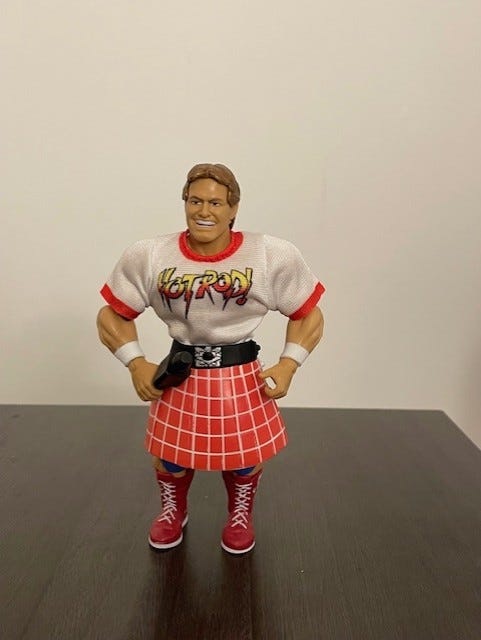
This post is brought to you by Undisputed, a pro wrestling comic book by P.J. Curling. Available now from pjcurling.me.
.
I first started watching professional wrestling in the Fall of 1985.
The first WrestleMania had just occurred earlier that year, and pro wrestling was in midst of an enormous surge of both mainstream visibility and popularity.
Like many new pro wrestling fans during this time, my initial exposure was to the WWE (then called the World Wrestling Federation or WWF for short).
I credit that first wave of pro wrestlers I was exposed to, WWE names like Andre the Giant, Randy “Macho Man” Savage, Greg “The Hammer” Valentine, Ricky “The Dragon” Steamboat, Junkyard Dog, Hulk Hogan and Iron Sheik to name but a few, for capturing my initial interest in pro wrestling itself.
The compelling collective nature of this colorful assortment of talent resulted in me watching all the weekly TV WWE shows and attending live events. I also bought all the newsstand wrestling magazines every month (and there was at least a dozen of them) so I could learn more about the wrestlers.
I quickly became immersed in the world of professional wrestling.
One wrestler during this time enamored me more than any other.
His name was “Rowdy” Roddy Piper.
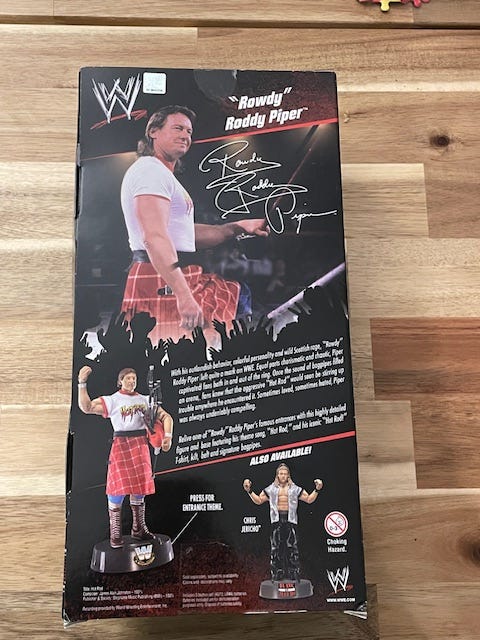
.
HATING PIPER
I absolutely hated Roddy Piper as a fan.
He was getting the reaction from me that WWE wanted people to have from him. They wanted people to vehemently despise him.
In close retrospective analysis decades later, I found a lot to like about Piper the character.
He spoke his mind whenever he talked and there was kind of a no-nonsense approach to him. It was a sort of cocky confidence.
Piper was funny too.
Back then I’d find myself as time went on laughing at some of the things he said, although I’m sure that was the intention on some level as the soft foundation was laid for his eventual turn less than the two years after the inaugural WrestleMania where he was cast as the ultimate villain.
It was Piper’s verbal delivery that eventually won me over. There was a kind of maniacal ranting cadence to the way he talked.
In the mid ’80s WWE explosion of popularity, “Rowdy” Roddy Piper played a pivotal role, and in my opinion was just as important and responsible as Hulk Hogan for the wrestling boom that happened.
Roddy Piper was the “bad guy” in the script.
Back then, the characters were clear in their roles.
We had the rulebreakers on one side and the fan favorites, or “good guys”, on the other side.
There was nothing in the middle.
As fans, we would be shocked when a good guy turned “bad”.
This could effectively be done by simply attacking and laying out your tag team partner, like when “Mr. Wonderful” Paul Orndorf did it to Hulk Hogan on Saturday Night’s Main Event. Then Orndorf gave Hulk a piledriver. This was all to my shock as I listened to the event on a TV radio as it was broadcast on network television.
Why the radio?
The main event of the pre-taped show aired on TV at the very late time of 12PM and most of us fans back then recorded it on our VCR to watch the next day,
As fans, we were supposed to, and generally did, loudly boo a wrestler for their dastardly deeds.
And if they were especially good at being bad back in the 80s, we were supposed to even hate them for their despicable behavior, or at least the promoters wanted us to.
Sometimes though, no matter how rude the heel was, how much he cheated, or how obnoxious the behavior was that he displayed, we grew to like him because he was entertaining.
My personal case example of this was “Rowdy” Roddy Piper.
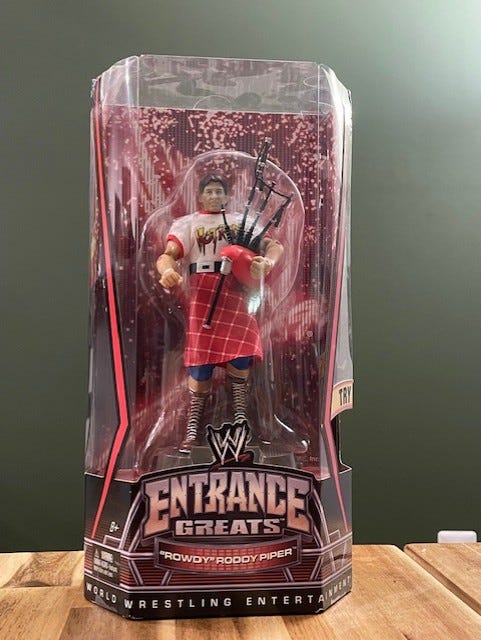
“ROWDY” RODDY’S ARRIVAL IN THE WWE AND PIPER’S PIT
Roddy Piper was first brought into WWE as a manager. Surprisingly, that was the idea they had for him and apparently there was not an initial plan for him to be a full-time wrestler.
I didn’t realize that until very recently when I was looking up some information about him.
It’s quite odd in retrospect.
So, Roddy Piper joined WWE in 1983 as a manager. This despite him being a very big wrestling star in the early 80s in the Georgia territory and in the Mid-Atlantic territory. Going back a little further than that, Piper was a huge star in the Portland territory in the late 70s.
Somehow all that extensive and noteworthy body of work led to WWE concluding Piper was best suited for a manager role. In his initial appearance in the promotion, he debuted as Dr. D David Schultz’s manager.
Piper didn’t last long as a WWF manager because by early 1984 he was wrestling and shortly after that the Piper’s Pit interview segment debuted on TV. His short stint as a manager has largely been forgotten about over time.
It was his talking that got Piper over huge in my opinion at the beginning, and Piper’s Pit was the ideal vehicle to showcase his extraordinary ability to speak on the mic in a way that captivated an audience.
I’m not saying he didn’t have exciting matches, but it was really the talking of “Rowdy” Roddy Piper that separated him, and I believe it was what made him different in that era and is ultimately his legacy.
Piper’s wit and timing were exceptional on the mic. There was a special way in which he delivered the lines, almost laughing as he spoke in a conceited manner. He delivered a lot of iconic moments on Piper’s Pit too.
There was the segment where he smashed a coconut over Jimmy Snuka’s head, igniting a heated feud.
Another memorable segment saw him invite preliminary wrestler Frankie Williams onto the show, only to quickly begin verbally berating him because he had never won a match in WWE. Then Piper started abruptly beating him up. There was something intensely cruel-hearted, sadistic, and somehow humorous in the way he decimated Williams, with a running dialogue going on at the same time.
Who can forget the time he, with Pit henchman Bob Orton’s assistance, shaved The Haiti Kid’s head?
I mean, Roddy Piper was always a total jerk during his first few years that he was in WWE.
It wasn’t just in the way he talked but also in his mannerisms and actions.
Piper was able to bring me in as the viewer into the storyline and become emotionally attached to what I was watching. That’s no easy feat.
He got his points across at times completely by his mannerisms, so it’s not always about the verbal word. Sometimes it’s all about facial expressions, and that takes a special and unique skill set to excel in that way.
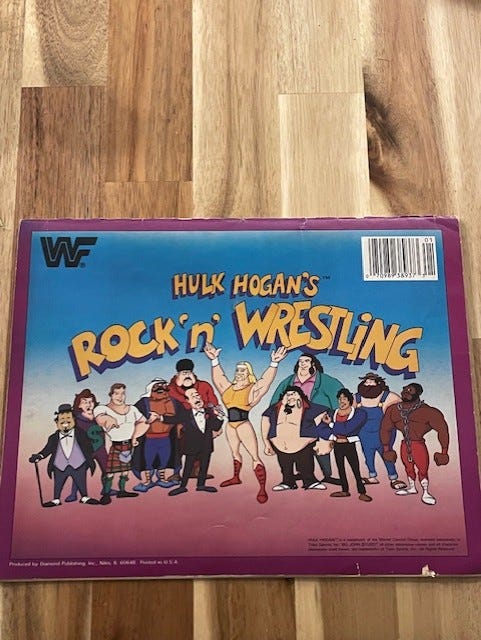
PIPER, THE MID-80s WRESTLING BOOM AND THE ROCK-N-WRESTLING CONNECTION
The Rock-n-Wrestling Connection was huge in the mid ’80s and is very important in the context of pro wrestling history, the enormous surge of popularity of WWE at the time it was occurring, and arguably pro wrestling itself. There was definitely a trickle-down effect during the mid ’80s WWE boom that put more eyes on wrestling in general.
Now, you could argue that in the ’80s, as a result of WWE’s growth, most of the regional promotions went out of business, and other larger promotions didn’t ultimately survive either.
However, WWE’s success created wrestling fans, people like me, who started watching WWE back then and quickly started watching other wrestling promotions too. This was the trickle-down effect in my view in terms of what The Rock-n-Wrestling connection did.
So, what exactly was The Rock-n-Wrestling Connection?
The Rock-n-Wrestling Connection was a mixing of two worlds, pro wrestling and music, and it was masterful marketing to boost wrestling.
A centerpiece of this was the popularity of an icon from that era, Cyndi Lauper, who had a hit song, Girls Just Want to Have Fun.
The origins of the Rock-n-Wrestling connection occurred in 1983 when Captain Lou Albano, a WWE manager and former wrestler, played Cyndi Lauper’s father in the music video for Girls Just Want to Have Fun.
In early 1985, Cyndi Lauper was at Madison Square Garden for an awards presentation, where she gave Albano a gold and platinum record for his work with the MS Foundation.
In that same ceremony, Lauper was presented with an achievement for her participation in the WWE. Actually, WWE TV commentator Gorilla Monsoon referred to it as her contribution to “the world of pro wrestling.”
At the time, that was laughable to most wrestling fans. However, when you think about how impactful this whole angle was on the history of wrestling and in making wrestling substantially more popular by exposing it to a lot of people, the comment is actually quite apt in retrospect.
During the ceremony, while Lauper is giving Albano the records, Roddy Piper interrupts the proceedings, and it’s masterful the way he does it.
He just walks out there in his wrestling tights, he’s not even wearing a ring robe or a shirt, and just very matter-of-factly interjects himself.
In fact, he barely speaks at all. He just says a few words, telling Albano that he wants to look at the records. It’s not clear why he’s there at all.
Then Piper takes the record and just boom, with no preamble, smashes it over Lou Albano’s head. Cyndi Lauper tries to cover Lou Albano, who has fallen to the mat, to protect him, and Piper kicks her. Then he grabs her music manager, David Wolff, who is in the ring, and he puts him in this kind of running power slam and just hurls him.
The announcers called it a running power slam, but it just looked like him throwing Wolff across the ring and not a power slam to me.
The thing that made all this look so good is that it looked real in Piper’s delivery, and it looked very spontaneous the way they all executed it.
That’s very impressive when you think that two of the four participants here were not trained wrestlers.
It was also such a heelish thing for Piper to do, and the beauty of it is in its simplicity.
It’s heeling 101 to attack the non-wrestler in any scenario.
After Pipers throws Wolff, Hulk Hogan comes in and runs Piper off. This was all a set up for an MTV special that year called The War to Settle the Score that aired on February 18th,1985.
That was a one match show, broadcast live, for the WWE title with Hulk Hogan defending against “Rowdy” Roddy Piper, and the idea was that this would serve as the set up to WrestleMania.
Hulk Hogan won the match by disqualification when “Mr. Wonderful” Paul Orndorf and “Cowboy” Bob Orton got involved. They attacked Hogan, and Mr. T came to the ring to help Hogan. Mr. T was a very popular TV actor at the time and on a show called The A-Team. He was also in Rocky III a few years before that as the primary villain, so by the spring of 1985, he had huge mainstream visibility.
Having this on MTV was important. It was still a relatively new medium and fresh, as it had only been around a couple of years, and it was very popular. This exposed pro wrestling to a whole new audience. It made it look cool, and this was a key marketing point for the first WrestleMania in making it a rousing success, bringing in a lot of those new wrestling viewers to watch the event.
The main event at WrestleMania building off this was Piper and Orndorf versus Hogan and Mr. T. The bad guys lost, and Hogan and Mr. T got the win, and as the cliché goes the rest was history.
The first WrestleMania set WWE off and running. If WrestleMania had flopped, the entire wrestling industry would very likely be much different today. The event, however, was such a huge deal at the time that people who weren’t wrestling fans were talking about it.
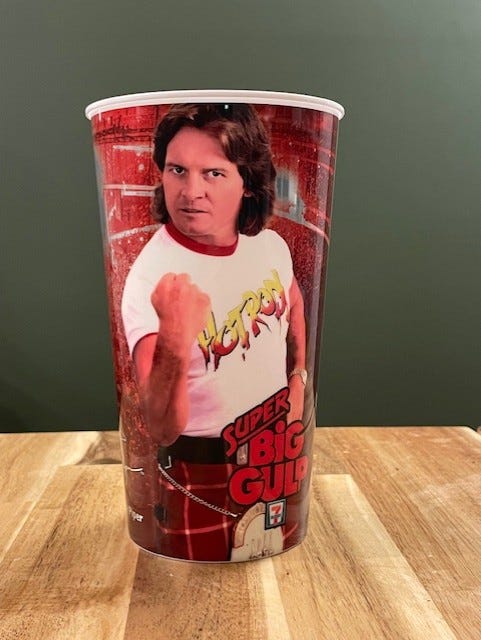
PIPER THE GOOD GUY
Piper left WWE for a short period of time in 1986 after WrestleMania 2 and when he returned, they made him a good guy.
The way they did the character turn was straightforward and basic. People already kind of liked Piper because he was so entertaining, even though he was supposed to be this big heel.
Piper’s Pit had been replaced by a show called The Flower Shop, hosted by “Adorable” Adrian Adonis.
“Cowboy “Bob Orton served as the bodyguard/henchmen for Adonis, the role he had prior with Piper.
When Piper came back, it was the same Piper that destroyed The Flower Shop set. He didn’t change his demeanor. He wasn’t like,” Hey, I’m a good guy now because I’ve adjusted my attitude.”
No, he just strode out there, had a bat, didn’t say much and destroyed the set of The Flower Shop.
This was the Roddy Piper who left before in every sense. He was just now turning his attention to someone that fans didn’t like.
I see elements of Piper in many modern wrestlers.
One of note is MJF.
For me as a long-time pro wrestling viewer, I saw so many parallels in mannerism and speech and presentation between Roddy Piper and MJF when MJF first burst into the main event scene a couple of years ago. I pondered at the time whether MJF studied Roddy Piper’s body of work at some point and incorporated certain elements with his own twist, or if it was all just natural.
Regardless, I can’t emphasis enough as someone who watched Roddy Piper in his prime that there were clear similarities between the two for me when watching MJF during his first major push in AEW.
“Rowdy” Roddy Piper is timeless in that his work still resonates decades later, and I believe it will be the same for future generations that go back and watch him as well.
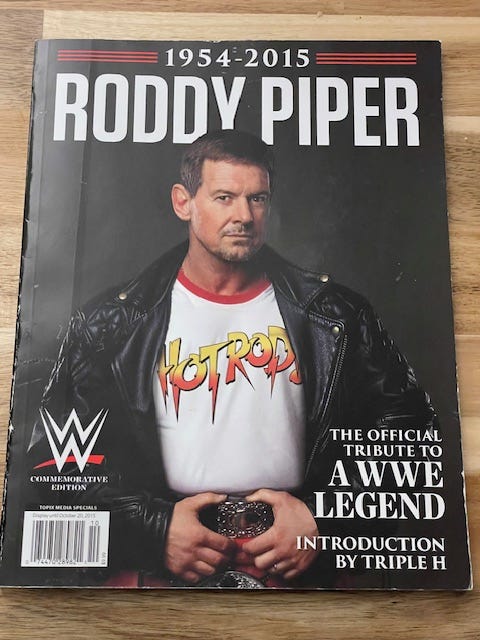
Roddy Piper died in 2015.
You can subscribe for free to The Pro Wrestling Exuberant to receive all my new posts via email, as well as new episodes of my own podcast, Only The Best Independent Wrestling.
By becoming a free subscriber, you will also be able to access my Substack website to see the full archive of all my pro wrestling posts. This is also where the full archive of my Notes collection is housed. Notes is shortform writing from me on a variety of topics related to pro wrestling and my writing process.
If you like my pro wrestling writing, please consider upgrading to a paid subscriber for $5 a month to get exclusive content, like posts about and pictures of wrestling memorabilia from the ‘80s to present from my personal collection, as well as subscriber exclusive audio recording about ‘80s/’90s pro wrestling and original manuscripts, with updated commentary, of pro wrestling magazine articles I wrote in the ‘80s and ‘90s.
Follow me on Bluesky for more pro wrestling content.



